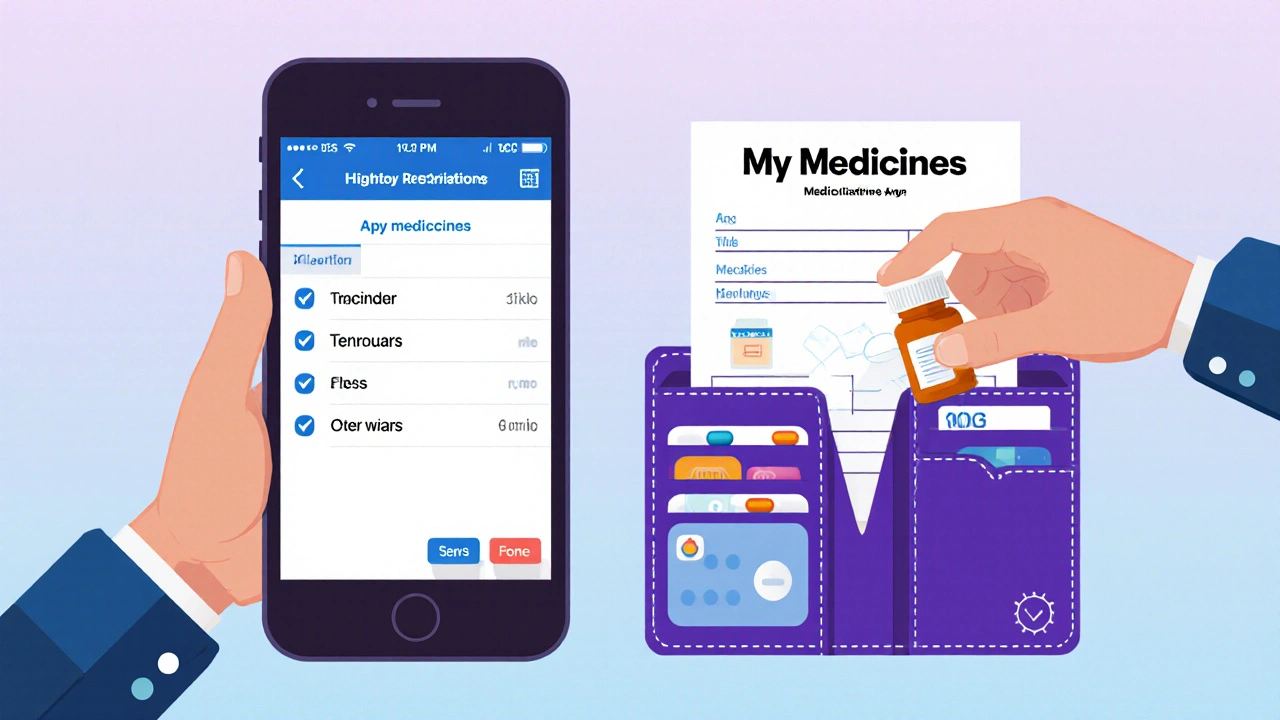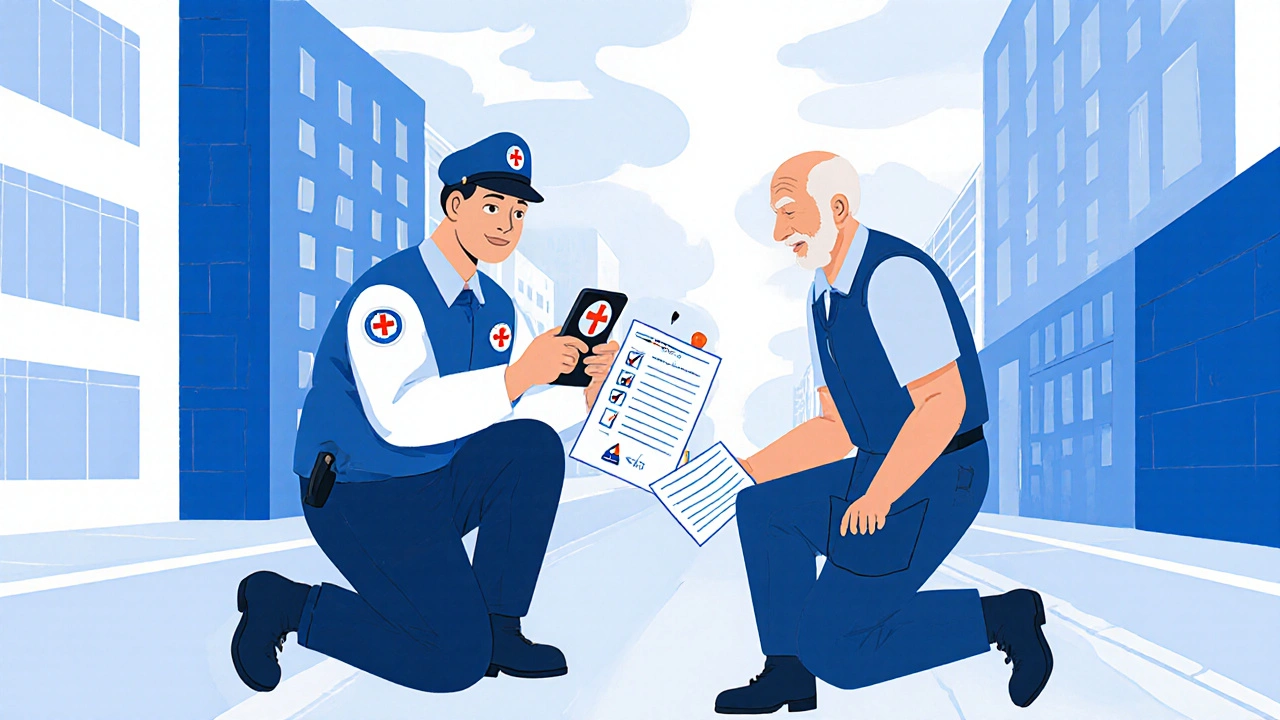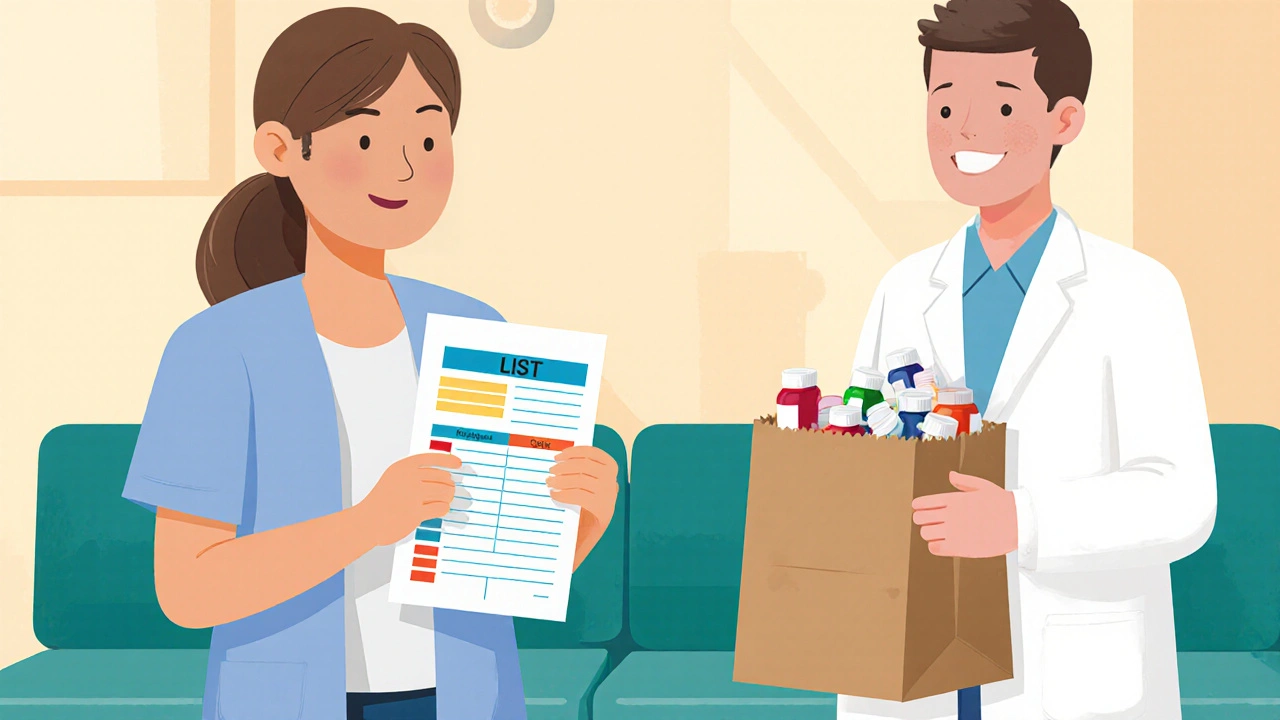Every year, around 7,000 people in the U.S. die from medication errors. Many of these deaths aren’t caused by bad doctors or faulty drugs-they happen because no one knew what medications a patient was really taking. A simple, updated list of all your pills, supplements, and OTC drugs can prevent most of these mistakes. It’s not just a piece of paper. It’s your safety net.
Why Your Medication List Matters
Think about the last time you visited a doctor, emergency room, or hospital. Did they ask you what you were taking? If you had to guess, you’re not alone. Most people forget something-maybe it’s that daily aspirin, the turmeric supplement, or the cough syrup they only use when they’re sick. But those “small” meds can interact dangerously with prescriptions. Warfarin, for example, can become deadly if taken with certain herbal supplements or even some painkillers. A 2023 study found that over half of patient-reported medication lists had at least one critical error. That’s not a typo. Half. The fix? A real, current, detailed list. The Joint Commission, which sets hospital safety standards, now requires every care transition-whether you’re going home from the hospital, switching doctors, or being admitted to a nursing home-to include a full medication reconciliation. That means someone has to compare what you say you take with what’s in your records. If your list is outdated or incomplete, that process fails. And you’re at risk.What to Include on Your List
A good medication list isn’t just a name and a dose. It’s a full picture. Here’s exactly what you need:- Drug name - Both brand and generic (e.g., “Lipitor” and “atorvastatin”)
- Strength and dose - 10 mg, 500 mg, etc.
- How often - Once daily, twice a week, as needed
- How you take it - By mouth, patch, inhaler, injection
- Why you take it - “For high blood pressure,” “for joint pain,” “for sleep”
- Last time you took it - Especially important for PRN (as needed) meds
- Who prescribed it - Doctor’s name or clinic
- Allergies and reactions - Not just “penicillin allergy”-specify what happened (rash, swelling, trouble breathing)
- OTC meds, vitamins, and supplements - Even if you think they don’t count. Garlic pills, fish oil, melatonin, and iron tablets all matter.
Choose Your Format: Paper, App, or EHR
There’s no one-size-fits-all format. Your best choice depends on how you live.Paper Lists
The FDA’s free “My Medicines” template is simple, clear, and works even if your phone dies. Print it out, fill it in, and keep a copy in your wallet, purse, or glove compartment. Many hospitals and pharmacies hand these out. The upside? No tech needed. The downside? It gets outdated fast. If you don’t update it after every change, it’s worse than useless-it’s misleading.Smartphone Apps
Apps like Medisafe, MyTherapy, and CareZone do more than store a list. They send reminders, track refills, and let you share your list with family or doctors. A 2023 BMJ Open study showed users missed 28% fewer doses. But here’s the catch: only 35% of adults over 65 regularly use them. If you’re not tech-savvy, or if your eyesight or hands make typing hard, these can feel like more trouble than they’re worth.Electronic Health Record (EHR) Portals
If you use MyChart (Epic), MyHealth (Kaiser), or another patient portal, check if it has a built-in medication list. These are synced with your doctor’s records, so changes made by your provider update automatically. That’s huge. But they only work if your doctor uses the same system-and not all do. Plus, you still need to review it. One patient told me she thought her list was accurate… until she saw her portal showed a drug her doctor had discontinued six months ago. She hadn’t noticed.
How to Keep It Updated (And Actually Do It)
The biggest reason medication lists fail? People forget to update them. A University of Michigan study found 68% of patients don’t update their list after leaving the hospital. That’s dangerous. Here’s how to make updating stick:- Update after every change - If your doctor adds, stops, or changes a dose, update the list that same day.
- Use the “brown bag” method - Every six months, gather all your meds in a brown paper bag and bring them to your appointment. Your pharmacist or doctor can compare what’s in the bag to your list. It catches hidden pills, expired meds, and duplicates.
- Take a photo of each bottle - Many geriatric pharmacists recommend this. Snap a picture of the label when you get a new prescription. Store them in a folder on your phone labeled “Medications.” You’ll never forget the dose again.
- Schedule a “meds check” - Pick one day a year-your birthday, tax day, or the first Monday of spring-and sit down with your list. Review every item. Ask: Do I still take this? Why? Is there a better option?
How to Share It
A list that stays in your drawer isn’t helping anyone. You need to share it.- Give a copy to your primary doctor - Ask them to keep it in your chart.
- Share with your pharmacist - They can spot dangerous interactions you might miss.
- Give one to a trusted family member - Especially if you live alone or have memory issues.
- Bring it to every appointment - Even if you think your doctor already has it. Different systems don’t talk to each other. Always bring your own.
- Use your phone’s emergency contact feature - Most smartphones let you add medical info to the lock screen. Add your meds and allergies. First responders can access it without unlocking your phone.

Common Mistakes (And How to Avoid Them)
People make the same errors over and over:- “I don’t take that anymore.” - You might think you stopped, but your doctor didn’t cancel it. Check your pharmacy records.
- “It’s just a vitamin.” - Supplements can interact with blood thinners, heart meds, and even antidepressants. Always list them.
- “I only take it when I need it.” - If you don’t write down when you last took it, doctors can’t tell if you’re overdosing or underdosing.
- “My list is in my app.” - What if your phone breaks? What if your app crashes? Always have a paper backup.
What Happens When You Get It Right
Kaiser Permanente cut medication-related readmissions by 22% in 18 months just by standardizing how patients kept and shared their lists. That’s thousands of avoided hospital stays. Dr. Scott Gottlieb, former FDA Commissioner, called accurate medication lists “the single most important tool for preventing adverse drug events.” And he’s right. A 2023 review of 47 studies found that when pharmacists led medication reconciliation, adverse events dropped by over 31%. When doctors did it alone, the drop was only 18.5%. Why? Pharmacists are trained to dig deeper. They ask the questions doctors don’t have time for. You don’t need to be a medical expert to keep a good list. You just need to be consistent. And you need to treat it like your health insurance card-something you never leave home without.What should I do if I can’t remember all my medications?
Call your pharmacy. Most can print out a complete list of all your filled prescriptions for the past year. Then, go through your medicine cabinet and add anything you take that’s not prescription-vitamins, supplements, OTC pain relievers, or creams. If you’re unsure about something, bring the bottle with you to your next appointment.
Should I include herbal supplements and vitamins?
Yes. Always. Herbs like St. John’s Wort can interfere with antidepressants. Garlic and ginkgo can thin your blood. Even common supplements like vitamin E and fish oil can affect surgery or blood pressure meds. Your doctor needs to know everything you’re putting in your body.
How often should I update my medication list?
Update it immediately after any change-new prescription, stopped drug, dose adjustment. At a minimum, review it every six months. Set a reminder on your phone or calendar. If you take five or more medications, make it a quarterly habit.
Can I use a digital app instead of paper?
Yes, but don’t rely on it alone. Apps are great for reminders and sharing, but they can fail-battery dies, app crashes, phone lost. Always have a printed copy. Keep it in your wallet, purse, or with your emergency contacts. Digital is helpful, but paper is your backup.
What if my doctors use different systems?
That’s normal. Most healthcare systems don’t share records automatically. That’s why you need to carry your own list. Don’t assume your cardiologist has the same info as your primary care doctor. Bring your list to every appointment, no matter who you’re seeing.
Is there a free template I can use?
Yes. The FDA offers a free, printable “My Medicines” form on their website. It includes space for prescriptions, OTC meds, supplements, allergies, and emergency contacts. Print two copies-one to keep with you, one to leave with a family member.



 Medications
Medications





vinod mali
November 17, 2025 AT 18:33Just made my list on paper after reading this. Took 5 mins. Put it in my wallet. No app needed. Done.
Georgia Green
November 18, 2025 AT 05:59i made a list last year but forgot to update it after my doc switched my blood pressure med. i just found out the app still had the old one. oops. now i take pics of every bottle when i get it. saves my butt.
Rob Goldstein
November 18, 2025 AT 14:47As a clinical pharmacist, I can’t stress this enough-medication reconciliation is the single most underutilized safety intervention in primary care. Patients often don’t realize that even OTC NSAIDs can precipitate renal failure in those on ACE inhibitors or diuretics. And don’t get me started on St. John’s Wort and SSRIs-it’s not folklore, it’s pharmacokinetic hell. The brown bag method? Gold standard. I’ve caught dupes, expired meds, and even patients taking two different brands of the same generic. If you’re on five or more meds, you’re not just at risk-you’re in the danger zone. Update your list after every visit. Not tomorrow. Today.
Ashley Unknown
November 20, 2025 AT 07:12EVERYONE KNOWS THE GOVERNMENT AND PHARMA ARE PUSHING THIS TO CONTROL US. WHY DO YOU THINK THEY MAKE YOU WRITE DOWN EVERY SINGLE THING YOU TAKE? THEY’RE TRACKING YOU. MY DOCTOR CHANGED MY MEDS WITHOUT TELLING ME AND NOW I’M ON A LIST? THAT’S NOT SAFETY, THAT’S SURVEILLANCE. AND WHY DO THEY WANT YOU TO USE APPS? TO COLLECT YOUR DATA. I’VE SEEN THE PATENTS. THEY’RE SELLING YOUR MEDICATION HISTORY TO INSURANCE COMPANIES. DON’T BE FOOLED. I KEEP EVERYTHING IN A LOCKED BOX. NO DIGITAL. NO PAPER. JUST ME AND MY BOTTLES. THEY CAN’T TRACK ME IF I DON’T TELL THEM. AND YES I KNOW THIS SOUNDS CRAZY BUT I’VE DONE THE RESEARCH. THEY’RE WATCHING. THEY’RE ALWAYS WATCHING.
Matt Wells
November 21, 2025 AT 00:53While the intent of this article is laudable, its lack of rigorous citation to peer-reviewed literature undermines its credibility. The claim that 7,000 annual deaths are attributable to medication errors stems from a 2006 IOM report, which has since been heavily contested for methodological flaws. Moreover, the assertion that pharmacists reduce adverse events by 31% is drawn from a meta-analysis with significant heterogeneity. A truly evidence-based approach would require stratification by comorbidity burden, polypharmacy index, and healthcare system architecture-none of which are addressed here. One cannot simply recommend ‘paper backups’ without acknowledging interoperability standards like FHIR or HL7 v3. This is well-intentioned but dangerously oversimplified.
Margo Utomo
November 21, 2025 AT 13:13YES. YES. YES. 🙌 I just got back from my grandma’s house and she had her meds in a Tupperware container labeled ‘stuff’ with no labels. I cried. I made her a list. I printed it. I laminated it. I put it on her fridge with a magnet. She’s 82. She’s gonna live longer now. 💪💊❤️
Robert Merril
November 22, 2025 AT 04:09so i spent 20 minutes writing my meds down then realized i forgot my fish oil. then i remembered i stopped taking it 3 months ago. then i realized my doc still prescribed it. then i checked my pharmacy and they still had it on file. then i realized my app says i take it every day. so now i have to call my doc to fix it and my wife is mad because i spent 45 minutes on this instead of helping with dinner. why is this so hard
Christina Abellar
November 24, 2025 AT 01:38This is the most important thing I’ve done for my health this year. Simple. No drama. Just a list. I keep it in my purse. I show it to every provider. Done.
Eva Vega
November 24, 2025 AT 12:24Medication reconciliation protocols are a cornerstone of transitional care management under CMS guidelines. The absence of a comprehensive, real-time list introduces significant risk for adverse drug events, particularly in geriatric populations with reduced hepatic metabolism and polypharmacy. I routinely audit patient lists during care transitions and identify discrepancies in 68% of cases. The FDA template is adequate, but integration with EHR-based tools like Epic’s MedList module reduces error rates by 42% compared to manual entry. Always validate against pharmacy dispensing records.
Noel Molina Mattinez
November 25, 2025 AT 17:20my neighbor died last year from a drug interaction because he didn’t tell his doctor he took ginkgo. he thought it was just for memory. now i go through everyone’s medicine cabinet. i don’t care if they’re mad. i saved my cousin from a stroke by spotting her blood thinner conflict. someone’s gotta do it
Jennie Zhu
November 25, 2025 AT 18:28It is imperative to underscore that the integrity of the medication reconciliation process is contingent upon the accuracy and currency of the patient-reported inventory. In clinical practice, the absence of standardized documentation formats frequently results in miscommunication during care transitions. The Joint Commission’s mandate is a necessary but insufficient intervention. We must implement mandatory electronic interoperability across all EHR platforms and mandate pharmacist-led reconciliation as a standard of care-not an optional service. Furthermore, patient education must be institutionalized within the primary care workflow, not relegated to handouts. The consequences of noncompliance are not merely statistical-they are mortal.
Deepali Singh
November 27, 2025 AT 01:167000 deaths? That’s not from errors. That’s from overprescribing. The system is broken. Doctors prescribe 5 drugs to fix side effects of 3 other drugs. Then they tell you to write a list. Why not stop prescribing so damn much? You’re not fixing the problem. You’re just asking patients to manage the mess they created.
George Gaitara
November 28, 2025 AT 21:36Wow. Another feel-good article that blames the patient for a system that’s designed to fail. You think the average person has time to update a list every time their doctor changes a script? Most people work two jobs. Most people can’t afford to miss a shift to go to the pharmacy. And you want them to take photos of every bottle? What about the elderly? The disabled? The homeless? This isn’t safety. This is victim-blaming with a checklist.
Margo Utomo
November 30, 2025 AT 01:14^^^ this. i’m a nurse. i see this every day. patients get overwhelmed. they’re tired. they’re scared. they don’t need another chore. they need better systems. not more paper. not more apps. they need their doctors to actually talk to each other. and maybe stop prescribing so much stuff in the first place. 🙃💊